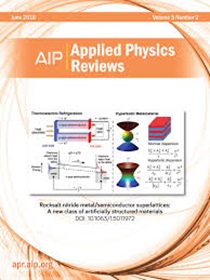作为血管支架一氧化氮生成涂层的胺功能化石墨烯的合成与表征
IF 11.6
1区 物理与天体物理
Q1 PHYSICS, APPLIED
引用次数: 0
摘要
药物洗脱支架通常用于治疗冠状动脉疾病,它们能保持血管通畅并防止再狭窄。然而,血管愈合时间延长、晚期血栓形成和新动脉硬化等问题依然存在;这些问题有可能通过内源性底物在局部产生一氧化氮(NO)来解决。在此,我们开发了胺功能化石墨烯,作为聚乳酸(PLA)基生物可吸收支架材料上的一氧化氮生成涂层。我们合成了由聚乙烯亚胺和聚乙二醇与氧化石墨烯(PEI-PEG@GO)结合而成的新型催化剂,并利用 X 射线衍射、拉曼光谱、傅立叶变换红外光谱和热重分析对其进行了理化表征。在 10 μM S-亚硝基谷胱甘肽(GSNO)或 S-亚硝基-N-乙酰青霉胺(SNAP)存在下,PEI-PEG@GO 分别催化生成了 62% 和 91% 的可用 NO。此外,PEI-PEG@GO 还增强并延长了生理条件下 GSNO 和 SNAP 生成 NO 的实时性。通过优化的简单浸涂方法,PEI-PEG@GO 被均匀涂覆在支架材料上。在加速降解测试中,涂层聚乳酸保持了良好的生物降解性,而 PEI-PEG@GO 涂层则基本保持完好。最后,涂层在室温下的稳定性得到了 60 天的验证。总之,聚合物胺与石墨烯的创新共轭可以催化 S-亚硝硫醇在生理相关浓度下生成 NO。这种方法为在生物可吸收支架上开发可控 NO 生成涂层铺平了道路,从而改善冠状动脉疾病的治疗效果。本文章由计算机程序翻译,如有差异,请以英文原文为准。
Synthesis and characterization of amine-functionalized graphene as a nitric oxide-generating coating for vascular stents
Drug-eluting stents are commonly utilized for the treatment of coronary artery disease, where they maintain vessel patency and prevent restenosis. However, problems with prolonged vascular healing, late thrombosis, and neoatherosclerosis persist; these could potentially be addressed via the local generation of nitric oxide (NO) from endogenous substrates. Herein, we develop amine-functionalized graphene as a NO-generating coating on polylactic acid (PLA)-based bioresorbable stent materials. A novel catalyst was synthesized consisting of polyethyleneimine and polyethylene glycol bonded to graphene oxide (PEI-PEG@GO), with physicochemical characterization using x-ray diffraction, Raman spectroscopy, Fourier transform infrared spectroscopy, and thermogravimetric analysis. In the presence of 10 μM S-nitrosoglutathione (GSNO) or S-nitroso-N-acetylpenicillamine (SNAP), PEI-PEG@GO catalyzed the generation of 62% and 91% of the available NO, respectively. Furthermore, PEI-PEG@GO enhanced and prolonged real-time NO generation from GSNO and SNAP under physiological conditions. The uniform coating of PEI-PEG@GO onto stent material is demonstrated via an optimized simple dip-coating method. The coated PLA maintains good biodegradability under accelerated degradation testing, while the PEI-PEG@GO coating remains largely intact. Finally, the stability of the coating was demonstrated at room temperature over 60 days. In conclusion, the innovative conjugation of polymeric amines with graphene can catalyze the generation of NO from S-nitrosothiols at physiologically relevant concentrations. This approach paves the way for the development of controlled NO-generating coatings on bioresorbable stents in order to improve outcomes in coronary artery disease.
求助全文
通过发布文献求助,成功后即可免费获取论文全文。
去求助
来源期刊

Applied physics reviews
PHYSICS, APPLIED-
CiteScore
22.50
自引率
2.00%
发文量
113
审稿时长
2 months
期刊介绍:
Applied Physics Reviews (APR) is a journal featuring articles on critical topics in experimental or theoretical research in applied physics and applications of physics to other scientific and engineering branches. The publication includes two main types of articles:
Original Research: These articles report on high-quality, novel research studies that are of significant interest to the applied physics community.
Reviews: Review articles in APR can either be authoritative and comprehensive assessments of established areas of applied physics or short, timely reviews of recent advances in established fields or emerging areas of applied physics.
 求助内容:
求助内容: 应助结果提醒方式:
应助结果提醒方式:


